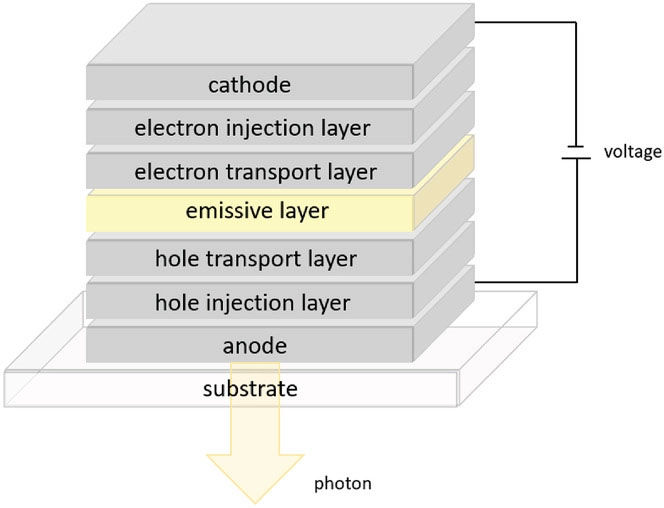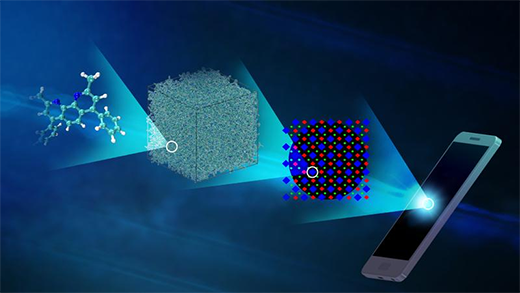OLED technology explained
Organic Light Emitting Diodes (OLEDs) have gained significant attention since researchers at Eastman Kodak pioneered the development of OLED technology in the 1970s and demonstrated the first low-voltage, commercially viable OLED device in 1987 (Applied Physics Letters, "Organic electroluminescent diodes"). Despite thousands of publications, patents, and reviews on OLEDs, researchers are still working on next-generation emitting materials and strategies to improve the light output and brightness of OLED devices, enabling simpler, more cost-effective lighting solutions in the future.
OLED technology is based on the phenomenon that certain organic materials – carbon-based compounds – emit light when an electric current is applied. These organic compounds are sandwiched between two electrodes, one of which is typically transparent.
The basic structure of an OLED consists of an emissive layer, a conductive layer, an anode, and a cathode. When a voltage is applied across the OLED device, electrons flow from the cathode to the anode, while positive charges move in the opposite direction. At the emissive layer, electrons and positive charges recombine, releasing energy in the form of photons (light). By carefully designing the organic compounds used in the emissive layer, OLEDs can emit a wide range of colors with high efficiency.

Efficient utilization of singlet and triplet excitons for energy conversion, as well as the charge injection process, is crucial. The device architecture also plays a significant role in determining the operating voltage and luminance efficiency of OLEDs.
In contrast to conventional light-emitting diodes (LEDs), organic LEDs (OLEDs) are no longer made of silicon. In OLEDs, thin layers of carbon-based molecules form pixels, which emit light. The color of a pixel can be adjusted by varying the molecular structure. OLED pixels normally consist of multiple layers which ensure, for example, that electrons can travel in the pixel with as little resistance as possible. The fine-tuning of the layer properties, for example, electron mobility or the emitted wavelength (color of the light), is a complex task.
For this purpose, they have established a molecular library of typical OLED materials. The idea of this library is to streamline the design of new molecular structures and to simulate the properties of the corresponding thin layers. The benefit is that this can be done prior to (expensive) synthesis, layer deposition, and characterization of an entire OLED (read more: Molecular library of OLED host materials).

Most efficient OLEDs have a multi-thin-film structure, which leads to a substantial fraction of generated photons being trapped within the device due to refractive index mismatch. Consequently, only 20-30% of energy can radiate outside the device, limiting the development of highly efficient OLEDs. Addressing this challenge and proposing strategies for efficient extraction of emitted light are critical for achieving high-performance devices.
Moreover, as OLEDs hold great potential for flexible displays and lighting, research has focused on flexible OLEDs and transparent conductive electrodes (TCEs), particularly ITO-free electrodes. Integrating light extraction strategies and flexible electrodes using appropriate device architectures can significantly enhance the efficiency of OLEDs, fulfilling the requirements of real-world applications.
OLED advantages over LCDs
Unparalleled Image Quality: OLED displays boast a superior contrast ratio compared to their LCD counterparts. Since each pixel emits light individually, OLEDs can achieve true blacks by simply turning off the corresponding pixels. This results in images with stunning contrast, vivid colors, and an overall richer visual experience.
Ultra-thin and Flexible: OLEDs do not require a backlight, which allows for thinner and more flexible display panels. This design flexibility has led to the creation of curved TVs, bendable smartphones, and even rollable displays.
Energy Efficiency: OLEDs consume less power than LCDs, particularly when displaying darker images. This is because each pixel consumes energy only when it emits light. Therefore, a dark or black pixel consumes minimal energy, while an LCD would still require a backlight. Consequently, OLEDs are more energy efficient, especially in applications with predominantly dark content.
Faster Response Time: OLED displays have a faster response time than LCDs, making them ideal for fast-paced video content, such as gaming or sports events. The swift pixel response time significantly reduces motion blur and ghosting effects.
Environmental Impact: OLED technology offers promising environmental benefits, but it is not without its challenges. The production process for OLEDs is relatively clean, with fewer harmful chemicals involved compared to LCD manufacturing. Moreover, OLEDs' energy efficiency contributes to reduced greenhouse gas emissions by consuming less electricity.
However, the use of certain heavy metals like iridium in some OLED compounds can pose environmental risks. These metals can be toxic and difficult to recycle. Researchers are actively working on finding alternative materials to minimize the environmental impact.
Challenges for OLED technology
Affordability remains a critical issue, as manufacturing costs must be reduced to compete with existing technologies and dominate the display and SSL market. Roll-to-roll fabrication technologies may help achieve this goal.
The rapid progress in inorganic LEDs for LCD backlights has led to a significant decrease in power consumption, weakening OLEDs' competitiveness. Directly applying advanced optical light extraction techniques to large areas at low costs remains a challenge.
Quantum dot LEDs (QLEDs) have gained considerable attention for their superior color purity compared to OLEDs. Although QLED technology is not yet mature, it has been successfully incorporated into advanced LCD displays, potentially challenging OLEDs' future applications. Read our glossary entry on Understanding Light-Emitting Diodes: LED, OLED, and QLED Technologies
The individual lifetimes of OLEDs, particularly blue devices, are shorter than those of other colors. Blue OLEDs are more challenging to create and have a shorter lifespan than green and red OLEDs. Achieving stable blue OLEDs using thermally activated delayed fluorescence (TADF) technology is still an ongoing task.
Future prospects for OLEDs
Despite these challenges, rapid progress in OLED development inspires confidence in the technology's potential for future lighting and displays. As scientific research in OLEDs continues to expand, it is likely that OLEDs will become an integral part of our everyday lives in exciting new forms.
